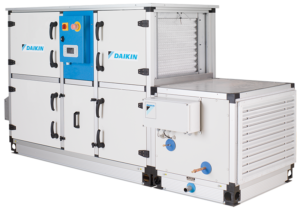There has perhaps never been such as a heightened focus on indoor air quality, with pressure to ensure a building’s occupants are provided with a well-ventilated interior space and an adequate supply of fresh, clean air. Here, Martin Passingham, Product & Training Manager at Daikin, explores this further. 
In the UK, Public Health England estimates that air pollution is responsible for between 28,000 and 36,000 deaths a year, costing the NHS and private healthcare sector £20bn annually. Nor is air pollution an issue limited to the outside environment only. According to the World Health Organisation (WHO), air pollution from both indoor and outdoor sources represents the single largest environmental risk to health globally.
Defined as the quality of air in and around a building, particularly in relation to the health and comfort of occupants, indoor air quality can be affected by numerous factors, with pollution coming from both interior and exterior sources. Sources of outdoor air pollution can include road traffic, industrial processes and construction and demolition sites, with particles able to enter into a building through natural or mechanical ventilation, as well as infiltrating through the building fabric. Indoor sources can include Volatile Organic Compounds (VOCs), which are given off by wall and floor coverings, furniture and appliances; dust, damp and mould; emissions from office equipment; and, of course, occupants themselves, who breathe out CO2 and can spread colds and viruses.
The effects of poor indoor quality can be significant, from the long and short-term impact on a person’s physical health (including exacerbation of cardiovascular and respiratory diseases) to their mental wellbeing also. It is thought to be a factor in conditions such as depression and bipolar disorder, as well as potentially having a detrimental effect on children’s learning abilities, patient recovery and workforce productivity.
We all spend a large portion of our daily life indoors – perhaps more so than normal in recent months. It is clear, therefore, that indoor air quality is a key issue to be considered in building design, from homes and offices to hospitals and schools, with effective ventilation at the core of achieving this.
Fundamentally, ventilation aims to remove stale indoor air and replace it with ‘fresh’ outdoor air. Correctly designed, installed, commissioned and serviced ventilation systems – as part of a building’s wider HVAC system – can help to prevent the ingress of outdoor pollution, extract water vapour, airborne pollutants and odours from the air and ensure a constant supply of fresh, clean air to occupants.
In order to deliver a clean, healthy and pleasant indoor environment, it is recommended that engineers take a holistic approach to designing the HVAC system and include ventilation as part of whole-building climate control, considering both the building’s fabric and the M&E systems.
In many ways, achieving effective ventilation requires finding a balance between energy efficiency and air quality. In modern building design, the pressure to reduce running costs and energy consumption, combined with the targets set by BREEAM and LEED assessments, mean the emphasis often falls on achieving high levels of energy efficiency. While this focus on making a building well-insulated and air tight can help to reduce the transmission of heat and lower energy bills, it does also make it difficult for there to be a fresh supply of air around a building – leading to low oxygen levels and increased potential for allergies and odours, as well as the risk of condensation build-up.
While opening a window may, on the surface, seem like an obvious solution to this, it can easily allow pollution from outside sources to enter into the interior space. What’s more, opening a window may not even be possible, especially in more modern buildings and high-rise developments, whether for energy-saving or security reasons.
Through careful design and consideration, however, it is possible to achieve both effective ventilation and energy efficiency, without leading to a compromise on the building’s indoor air quality. There are also whole building ventilation systems available with various energy efficiency features, such as variable refrigeration temperature control and the ability to use waste heat from cooling and refrigeration to heat other areas of a building.
For more information on designing, commissioning and how best to maintain and clean a building’s ventilation system, please visit www.daikin.co.uk/indoorairquality, where you can download Daikin’s ‘Delivering Good Indoor Air Quality’ whitepaper, as well as register for an upcoming industry webinar.

